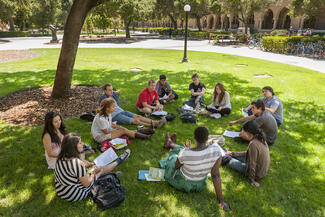
Understanding excited states in 2D and moiré materials for quantum applications
Physics & Astrophysics Building, Room 102/103 and Zoom
ABSTRACT: Low-dimensional materials, such as monolayer transition metal dichalcogenides (TMDCs), are marked by their spatial confinement, weak electronic screening, and large many-electron interactions. Such systems host a variety of multiparticle excitations – such as excitons, trions, biexcitons – often displaying large binding energies and long lifetimes even at room temperature. I will present new first-principles formalisms and calculations to understand the fingerprints of these excitations and their applicability for quantum science.
When two individual bilayers are stacked with a twist angle, a moiré pattern forms with a periodicity larger than that of the unit cells of the individual TMDCs. We developed a formalism to understand the spectroscopic signatures of such moiré-confined excitons. In collaboration with experimentalists performing time-resolved angle-resolved photoemission spectroscopy (TR-ARPES), we directly obtain the localization of excitons within a moiré unit cell, yielding a surprisingly localized radius of ~ 1 nm. I will also present results based on a recent first-principles formalism to simulate materials out-of-equilibrium while including many-body interactions. I will show that strongly pumped excitonic systems display band renormalization effects that have, in the past, been attributed to excitonic condensate/insulating regimes. We explain these effects in simpler terms as a system dressed by the excitonic field, which opens the door to systematically studying band structure engineering and optical nonlinearities in the 2D limit.
BIO: Felipe H. da Jornada is an Assistant Professor in the Department of Materials Science and Engineering at Stanford University. Before joining the faculty in 2020, Felipe received his Ph.D. in physics from UC Berkeley working with Prof. Steven G. Louie, and he was awarded the best thesis award from the Kavli Energy NanoScience Institute at UC Berkeley (2017). Felipe’s previous research focused on understanding the electronic and optical properties of atomically thin materials – such as graphene and mono- and few-layer transition metal dichalcogenides (TMDs) – using first-principles computational approaches. He is currently interested in employing a combination of new theoretical formalisms and massively parallel computer calculations to understand new excited-state phenomena in materials with applications in energy research, physics at reduced dimensions, and quantum information.
Q-FARM Seminars are held biweekly on Wednesdays, from 12-1pm. See website for our upcoming schedule.